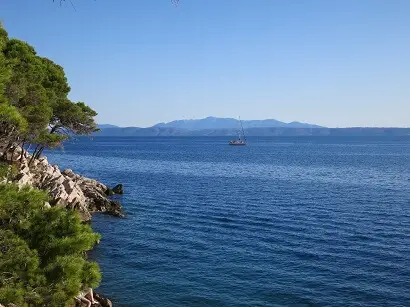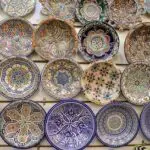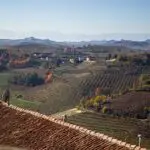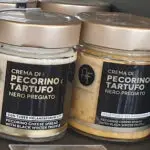There’s something almost romantic about the Adriatic Sea that distinguishes it from every other body of water around the world.

Crystal clear and almost unbelievably blue all year round, it’s easy to get lost in the Adriatic Sea – not literally, but emotionally and spiritually.
The reasons for the clear water on the Croatian coast are that there is little large-scale industry, the seabed consists mainly of coarse stones, algae find little food, and the current drives away all impurities.
But why exactly is the water in Croatia so blue? What makes it so unique and so distinct? Learn more below!
Why is the Water in Croatia So Blue?
The Adriatic Sea – located in the northernmost section of the Mediterranean – is a huge draw for tourists worldwide. We’re not just talking about regular holiday goers or vacationers, either.
Divers from around the world flock to Croatia, just the same way as sailors do – and for the same reasons.
The water here is crystal clear, unbelievably blue, and about as unspoiled as you are going to find water on this planet.
But why?
What makes the water in Croatia so blue?
Discoloring Algae is Starved in the Adriatic
Marine researchers describe the water around Croatia as being oligotrophic, which basically means there are so few nutrients in the water that discoloring algae love to feed on that the sea itself – quite literally – starves algae completely, stopping it from clouding or discoloring this water.
Now, at first, blush that might make you a little bit on the nervous side of things. We can tell you, however, that there’s absolutely nothing to worry about. This is totally natural, has absolutely nothing whatsoever to do with human intervention, and is just a big part of why Croatian water has always been described as unbelievably blue and crystal clear.
Without all of that algae, you have a different kind of marine life diversity swimming throughout the waters of Croatia, but you mostly don’t have to worry about the algae (and the waste algae produces) changing the color, clouding the water, or causing any discoloration.
The lack of algae is a huge piece of the puzzle behind why the Adriatic around Croatia is so blue!
There’s Little Sand and Silt to Cloud the Water
Of course, the lack of algae in the water around Croatia (to the point where this part of the address has been called a marine desert) Adriatic isn’t the only reason that the water is so clear.
Another big piece of the puzzle is that the Adriatic coastline along Croatia is mostly made up of bits of rock and stone instead of sand and silt.
Because there isn’t as much sand in Croatia (certainly not as much in the Adriatic) as in places like the Caribbean, for example, the water here stays almost completely clear from the surface all the way down to the bottom of the sea.
There isn’t any sand or silt to get kicked up, mixed around, or dispersed throughout the water. Waves aren’t going to be bringing tons of sand to the beach or pulling it away, either.
Sure, pebbles and stones are going to get moved and displaced by the motion of the ocean. But then they get gently deposited on the ocean floor and sort of sit there until they get moved again.
This keeps Croatian water super clear and likely always will.
Lack of Pollution, Too
Unlike a lot of other nations that have coastlines along Mediterranean Croatia didn’t spend time building up their industries – major, mechanized industries, anyway – up and down the coastline.
This kept a tremendous amount of pollution out of the water of the Adriatic around this beautiful holiday destination. It kept the water clean, it kept the water unspoiled, and it prevented the coastline from being transformed by man for the most part.
The sea currents throughout the Adriatic have also helped prevent a lot of pollution in the Mediterranean from finding its way into Croatian waters, too.
The currents pull water from Croatia (instead of bringing pollution into Croatian water), flowing southward along the Italian coastline to help keep this water-free and unspoiled.
Combine all of that with major investments and international interventions to protect the Adriatic Sea and the Croatian coastline in particular (especially interventions handled by MARPOL) and the end result are the deep blue, beautifully clear waters of this Mediterranean nation that are the envy of the world.
Closing Thoughts
At the end of the day, there are a couple of different reasons why the water in Croatia is so blue and so clear.
For starters, the lack of food and fuel for algae and other species of microbiology practically guarantees that the water maintains its blue hue all year round permanently. Researchers call this a “marine desert” because of the lack of nutrients that would have fueled that biodiversity otherwise, and while it is unique to this part of the world it is 100% natural.
Secondly, the lack of sand and the lack of silt on the coastline of Croatia – replaced instead with rocks and pebbles as well as the stone – means that the waters of the Adriatic near Croatia aren’t going to be cloudy, murky, or milky.
That helps visibility in a big way, but it also allows the light that reflects through the beautiful blue water to move almost completely unimpeded, resulting in a deeper blue hue that is immediately recognizable.
Finally, there’s just a lot less pollution in the water around Croatia than almost anywhere else in the Adriatic Sea (or the rest of the Mediterranean, for that matter).
Croatia did not put a lot of mechanized industry along its coastline for a number of different reasons, allowing these natural stretches of coast to remain whole and natural.
On top of that, a number of major anti-pollution investments and interventions (many of them done in conjunction with other nations) have cleaned up what little pollution was in this part of the Adriatic – pollution that didn’t get sucked out and funneled away thanks to the natural current.
The end result is some of the most beautiful deep blue, crystal clear water you’ve ever seen – water you have to see for yourself!
- The Top Restaurants Specializing in Truffle Dishes - August 10, 2023
- Truffle Panna Cotta: A Decadent Dessert Recipe for Truffle Lovers - August 7, 2023
- Truffle Scrambled Eggs: A Luxurious Breakfast Delight - August 7, 2023








